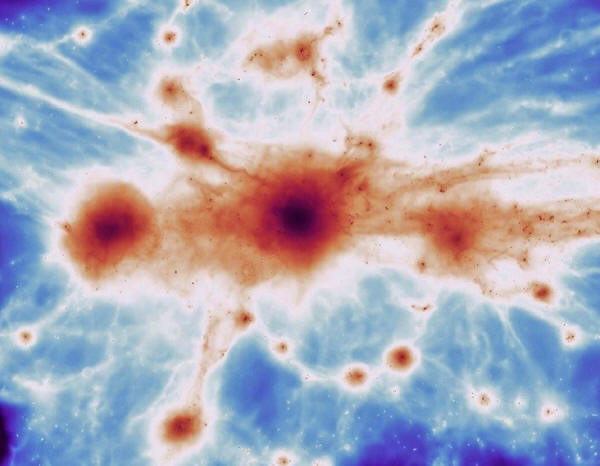|

by Richard A. Lovett
04
October 2019
from
CosmosMagazine Website
Italian version

This image shows filaments
in a
massive galaxy cluster
using
the C-EAGLE simulation.
Joshua Borrow using C-EAGLE
Astronomers have
confirmed it
by viewing gas
billions of
light years away...
Faintly glowing wisps of gas surrounding galaxies 12 billion
light-years away have given astronomers their first chance to
confirm the existence of a structure known as 'the cosmic web.'
The web is a cobweb of gas filaments, which the standard
model of cosmology predicts would have formed in the aftermath of
the Big Bang.
Where these giant
filaments cross, the theory goes, is where galaxies form.
Hints that such filaments might exist, says Erika Hamden, an
astrophysicist at the University of Arizona, Tucson, had previously
shown up in the spectra of distant galaxies, which contained
absorption bands indicating that the light from them had passed
through large hydrogen clouds en route to Earth.
"So you can tell
there's a bunch of hydrogen between you and the galaxies," she
says.
But whether that meant
the light had passed through one or more of the cosmic web's
filaments, or something else, was unclear.
In a paper (Gas
Filaments of the Cosmic Web located around Active Galaxies in a
Protocluster) published in the journal Science, however,
a team led by Hideki Umehata, an astronomer at the
RIKEN Cluster for Pioneering
Research, Japan, used one of the Earth's largest telescopes to
look at a massive protogalaxy known as
SSA22, 12 billion light-years away
in the direction of the
constellation Aquarius.
That's far enough away that the light from it had been traveling
toward us for most of the history of the Universe... meaning that
Umehata's team was peering back in time to only 1.8 billion years
after the Big Bang.
Umehata's team then ran the light through a spectroscope to look for
the glow of hydrogen illuminated by high-energy radiation from
nearby galaxies.
These galaxies "kind
of act like flashlights," explains Hamden, whose own paper (Observing
the Cosmic Web) commenting on Umehata's appears in
the same issue.
Detection was made
possible, she adds, by a spectrographic instrument called the
Multi Unit Spectroscopic Explorer (MUSE):
a high-resolution
spectrograph that allows astronomers to look for spectroscopic
signatures of things like hydrogen, over a wide field of view.
"That is the only
reason it could be done," Hamden says, "because these
structures are so big that you need a big field of view...
to see them."
It's an important result,
she adds, because the cosmic web is one of the key predictions of
the standard model of cosmology.
Finding a piece of it,
"is an indicator that
we're on the right track".
It's also important, she
says, because astronomers have long believed that most of the normal
matter in the Universe isn't in galaxies.
Proving that the web
exists is therefore an important step in figuring out where it does
lie. The next step, according to Umehata, is to look for more
filaments.
So far, he says,
"We just opened a
small window. The cosmic web should be much larger."
Also, he adds,
"it would
be useful to search for elements other than hydrogen, such as
helium or carbon, and to look for older filaments
closer to the Earth."
"It would be exciting
to see the evolution of filaments, and galaxy formation within
filaments, across cosmic time."
|


